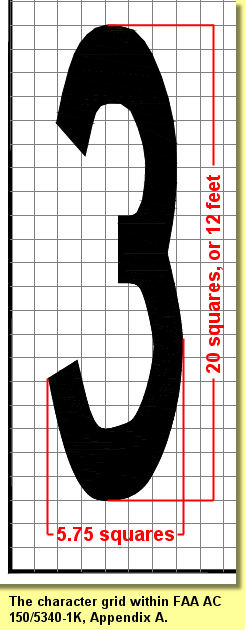 |
 |
Getting Off The GridBy Mike SpeidelMany of you are all too familiar with the FAA AC 150/5340-1K, relying on it for detailed guidance relating to airport marking configurations and dimensions. Despite the level of detail the AC's go into, I still get some pretty basic questions from the industry that don't seem to have answers. One recurring question of note has to do with stencil dimensions when painting red surface holding position signs. When I direct those inquiries to "the grid" on page 87 of the advisory circular, it often leads to more confusion, frustration, cursing, etc. What exactly seems to be the problem? The interesting thing about the grid in Appendix A is there are no exact dimensions associated with the alphanumeric characters for surface painted sign inscriptions. Unlike most other figures contained within the 5340, these characters don't have extension lines with assigned widths, lengths, or spacing. So we're left to figure it out for ourselves which, as you can imagine, leads to inconsistency throughout the industry. So what are we supposed to do? Despite the lack of specific dimensions, you can still derive relative dimensions using the grid as your guide. Take the "3", pictured on the right, as an example. We know that a typical character should be 12 feet in height. We also know each character is exactly 20 squares in height, according to the grid. Therefore we can divide 12 feet by 20 squares to arrive at 0.6 feet/square, or 7.2 inches. Knowing that each square is 7.2 inches, we can begin to determine how wide each character is. You'll quickly find most characters don't align perfectly with the grid lines, meaning you'll have to estimate how many squares each character is in width. Again, taking the "3" as an example, you can see the width of the number extends across 5 full squares and partially into adjacent squares on either side. By my eye, I've determined the number goes into about half of the square on the left of the "3" and about a quarter of the square on the right, for a total width of 5.75 squares. Phew! Give me a second, I'm trying to catch my breath... OK, so the "3" looks to be 5.75 squares in width. Multiply the number of squares by 7.2 inches (we calculated this earlier) to arrive at the width of our "3": 5.75 x 7.2 = 41.4 inches. That's a weird dimension, so you may decide to round it to the nearest whole number. Remember, this is only the width of the number at its widest point to assist in determining how wide your red backgrounds should be laid out. There are several dimensions associated with each character that are still not defined, but at least now you can estimate them. If you're using inscriptions that are 9 or 6 feet in height, calculate the width as I've described here, then add one last step: multiply the width by .75 for 9 foot characters OR multiply the width by 0.5 for 6 foot characters. How do I get off the grid? That's the real question. Until the guidance literature populates these figures with exact dimensions, we're stuck with the grid and brow-mopping algebra. We also don't have any definitive guidance on how much spacing should be allowed in between characters. The AC is very specific about the dimension of the red border around the outside of the characters, 15 inches. However, nothing is mentioned about the interior spacing(s). Logically speaking, I'd suggest the same 15 inch border in between characters to provide a consistent dimension around each character, however the FAA has not officially stated such a dimension. In the meantime, keep using the stencils as you have. Although stencil manufacturers work from the grid as well, and stencils often are different depending on where they were procured. Don't be surprised if your new stencils don't match your existing inscriptions exactly. For more about the grid, stencils, or to send love/hate mail, email Mike. |

